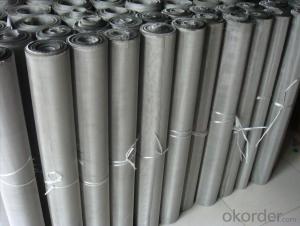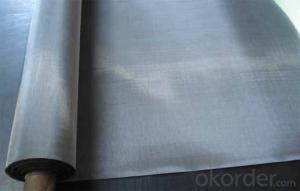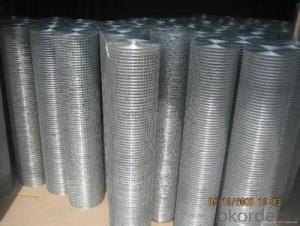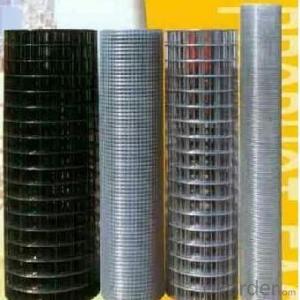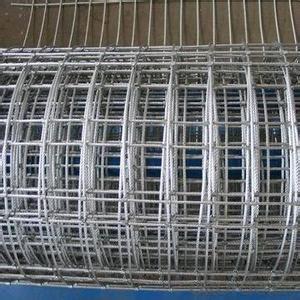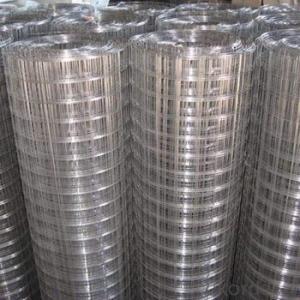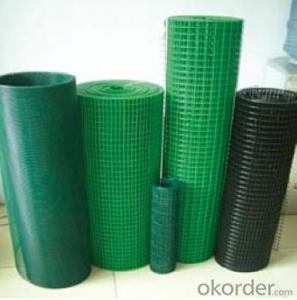Stainless Wire Mesh -- No.1 in China
- Loading Port:
- China main port
- Payment Terms:
- TT or LC
- Min Order Qty:
- 100 m²
- Supply Capability:
- 3000 m²/month
OKorder Service Pledge
OKorder Financial Service
You Might Also Like
1.Structure of Stainless Wire Mesh Description
The weaving type is determined according to our customers, specific requirements, such as the material, the wire diameter, the size of the mesh, width and length.There are four types of weaving, such as plain weave, twill weave, Dutch plain weave or Dutch twill weave. Plain weave is the most commonly used weave.
2.Main Features of the Stainless Wire Mesh
•Made of high quality steel wire.
•Various configurations and sizes
•Used for loose strata to aviod falling rocks.
•Suitable for shotcrete applications.
•Range of sizes to suit roadway width and bolting patterns.
•Easy installation,
•Avaliable in black or hot dip galvanized.
3. Stainless Wire Mesh Images



4. Stainless Wire Mesh Specification
Mesh / inch | Wire gauge(SWG) | Aperture(mm) |
3mesh*3mesh | 14 | 6.27 |
4mesh*4mesh | 16 | 4.27 |
5mesh*5mesh | 18 | 3.86 |
6mesh*6mesh | 18 | 3.04 |
8mesh*8mesh | 20 | 2.26 |
10mesh*10mesh | 20 | 1.63 |
20mesh*20mesh | 30 | 0.95 |
30mesh*30mesh | 34 | 0.61 |
40mesh*40mesh | 36 | 0.44 |
50mesh*50mesh | 38 | 0.36 |
60mesh*60mesh | 40 | 0.30 |
80mesh*80mesh | 42 | 0.21 |
100mesh*100mesh | 44 | 0.172 |
120mesh*120mesh | 44 | 0.13 |
150mesh*150mesh | 46 | 0.108 |
160mesh*160mesh | 46 | 0.097 |
180mesh*180mesh | 47 | 0.09 |
200mesh*200mesh | 47 | 0.077 |
250mesh*250mesh | 48 | 0.061 |
280mesh*280mesh | 49 | 0.060 |
300mesh*300mesh | 49 | 0.054 |
350mesh*350mesh | 49 | 0.042 |
400mesh*400mesh | 49 | 0.0358 |
500mesh*500mesh | 50 | 0.0273 |
Roll width:2’ -8’ | ||
5.FAQ of Stainless Wire Mesh
①The general use?
Welded Wire Mesh with excellent corrosion resistance and oxidation resistance, is extensively used as fencing, decoration and machinery protection material in agriculture, construction, transport, mine, sports field, lawn and various industrial fields
② Our Advantages?
1. Low cost for molding or tooling
2. Advanced & Standardization workshops and facilitates.
3. High-tech and high precision manufacturing equipment.
4. Strict ISO14001:2004 , ISO9001:2008 standards.
5. ROHS compliant & enviroment friendly products.
6. Professional technical specialists and management personel
7. 100% in house inspection before delivery
③Why you choose us?
We can make high precision parts from foil as thin as 0.025mm.
Main metal material we can photo etching including:
Stainless steel, iron, brass, copper, Kovar, Molybdenum
Surface can be paint color, gold/silver plated or mirror finish
Products can be made according to your drawing in .dxf or .dwg format.
Please feel free to contact us for the quotatio
- Q: How is steel wire mesh used in the textile industry?
- Steel wire mesh is commonly used in the textile industry for a variety of purposes, such as reinforcing fabrics, creating screens for printing or drying processes, and providing support for weaving or knitting machines. It is also used in the construction of textile machinery and equipment, enabling efficient production and ensuring the durability of textile products.
- Q: How is steel wire mesh used in the agriculture industry?
- The agriculture industry extensively employs steel wire mesh for various purposes. Fencing and enclosures are one of its primary applications. Steel wire mesh is frequently used to establish boundaries, safeguard crops and livestock, and prevent unwanted animals from trespassing into agricultural areas. Its robust and long-lasting nature ensures its resilience against the elements, providing reliable security. In addition, steel wire mesh finds significant use in plant support within agriculture. Gardeners and farmers often rely on wire mesh to construct trellises, cages, and supports for climbing plants like tomatoes, beans, and cucumbers. This aids in maintaining the plants' structure, preventing them from toppling over, and facilitating better air circulation and sunlight exposure. Consequently, this results in healthier crops with higher yields. Steel wire mesh is also commonly employed in constructing animal enclosures and cages. It finds frequent utilization in poultry and livestock farming, enabling the creation of secure and safe enclosures for animals. This prevents them from wandering off or becoming prey to predators. By adjusting the mesh spacing according to the animals' size and type, their well-being and safety are ensured. Furthermore, steel wire mesh plays a vital role in the manufacture of beekeeping equipment. It is used to construct bee hives and frames, providing a sturdy structure for the bees to construct their combs and store honey. The mesh's small openings allow for proper ventilation while effectively preventing the bees from escaping. To summarize, steel wire mesh is an indispensable component within the agriculture industry. Its versatility, strength, and durability make it the ideal material for fencing, plant support, animal enclosures, and beekeeping equipment. By providing essential security and support, it significantly contributes to the overall success and productivity of agricultural operations.
- Q: Is steel wire mesh resistant to saltwater corrosion?
- Yes, steel wire mesh is generally resistant to saltwater corrosion due to its composition and protective coatings. However, the level of resistance can vary depending on the specific type of steel used and the environmental conditions.
- Q: How is steel wire mesh used in the oil and gas industry?
- Steel wire mesh is widely used in the oil and gas industry for various applications due to its strength, durability, and corrosion resistance. One of the primary uses of steel wire mesh is in filtration systems. It is commonly used as a filter media to remove solid impurities and contaminants from fluids such as crude oil, natural gas, and drilling mud. The mesh size and porosity can be customized to suit specific filtration requirements, ensuring efficient separation of particles and solids. Steel wire mesh is also used for reinforcing purposes in oil and gas well drilling. It is employed to strengthen concrete structures such as well casings and platforms, providing stability and preventing collapse. In these applications, the mesh acts as a reinforcement material, enhancing the structural integrity and durability of the drilling infrastructure. Furthermore, steel wire mesh finds application in the construction of oil and gas pipelines. It is used as a protective layer to prevent soil erosion and stabilize the surrounding terrain. The mesh acts as a barrier, preventing the migration of soil particles and ensuring the stability of the pipeline. Additionally, steel wire mesh can be used to prevent animal burrowing and vegetation growth, minimizing potential damage to the pipeline. In offshore drilling operations, steel wire mesh is utilized as a safety measure. It is commonly used as a safety barrier or fencing on platforms and walkways to prevent accidental falls. The mesh provides a secure boundary while allowing for visibility and ventilation. Overall, steel wire mesh plays a crucial role in the oil and gas industry, contributing to filtration, reinforcement, pipeline protection, and safety. Its versatility, strength, and resistance to harsh conditions make it an ideal choice for various applications in this industry.
- Q: What are the benefits of using steel wire mesh in the pharmaceutical industry?
- Using steel wire mesh in the pharmaceutical industry offers several benefits. Firstly, steel wire mesh provides exceptional strength and durability, ensuring that it can withstand the rigorous demands of the pharmaceutical environment. Secondly, its open and interconnected structure allows for efficient airflow and visibility, making it ideal for applications such as cleanrooms and sterile environments. Additionally, steel wire mesh is resistant to corrosion and easy to clean, ensuring compliance with strict hygiene standards. Lastly, its versatility allows for customization, enabling it to be used for various applications such as filtration, screening, and containment.
- Q: Can steel wire mesh be used for creating bird or pest control barriers?
- Yes, steel wire mesh can be used effectively for creating bird or pest control barriers. Its sturdy construction and small openings make it an ideal material for preventing birds and pests from entering certain areas. The mesh acts as a physical barrier, keeping birds and pests out while still allowing airflow and visibility. Additionally, steel wire mesh is durable and long-lasting, making it a reliable option for creating bird or pest control barriers.
- Q: How does steel wire mesh perform in terms of resistance to wear?
- Steel wire mesh performs exceptionally well in terms of resistance to wear. Due to its strong and durable construction, it is highly resistant to abrasion, corrosion, and impact. This makes it suitable for various applications where frequent use, heavy loads, or harsh environmental conditions are involved. Its resistance to wear ensures a longer lifespan and minimal maintenance requirements, making it a reliable choice for industries such as construction, mining, and manufacturing.
- Q: Can steel wire mesh be galvanized?
- Indeed, it is possible to galvanize steel wire mesh. Galvanization involves the application of a protective zinc coating to steel or iron in order to prevent rusting. To achieve this, the wire mesh is initially cleaned and then submerged in a heated zinc bath, creating a metallurgical bond between the zinc and the steel. This galvanized coating provides exceptional resistance against corrosion, rendering the wire mesh suitable for outdoor applications where exposure to moisture and other environmental factors is likely. Additionally, the galvanization process enhances the longevity and durability of the steel wire mesh, making it a favored option in a variety of industries, including construction, agriculture, and fencing.
- Q: Is steel wire mesh recyclable?
- Indeed, steel wire mesh can be recycled. Steel, which is widely recycled worldwide, is one of the most frequently recycled materials. The process of recycling steel wire mesh involves melting it down and utilizing it to produce fresh steel items. By recycling steel wire mesh, we contribute to the conservation of natural resources, as well as the reduction of energy consumption and emissions linked to steel production. Moreover, recycling steel wire mesh aids in diverting waste away from landfills, promoting a more sustainable and eco-friendly waste management strategy.
- Q: Can steel wire mesh be used for reinforcement in concrete structures?
- Certainly, concrete structures can benefit from the use of steel wire mesh for reinforcement purposes. Welded wire mesh, also referred to as steel wire mesh, is a widely utilized option in enhancing the durability and strength of concrete structures. By welding steel wires together, a grid-like formation of intersecting wires is created. This mesh is implemented during the construction process by placing it within the concrete, effectively reinforcing it and preventing the propagation of cracks. Utilizing steel wire mesh as reinforcement in concrete offers numerous advantages. Primarily, it enhances the concrete's tensile strength, which is naturally weak under tension. The mesh acts as a sturdy framework that absorbs tensile forces, ensuring that the concrete is more resistant to cracks and structural failure. Furthermore, it assists in controlling shrinkage and thermal cracking by providing a reinforcement system that evenly distributes stress throughout the structure. Steel wire mesh is frequently employed in various concrete applications, including slabs, walls, pavements, and foundations. Its ease of handling, installation, and customization according to specific project requirements make it a preferred choice. The mesh is available in a variety of sizes and configurations, allowing for flexibility based on the intended application. It is crucial to note, however, that the effectiveness of steel wire mesh as reinforcement relies on proper installation and placement within the concrete. It is imperative to position it at the correct depth and securely anchor it to ensure optimal performance. Additionally, the quality and grade of the steel used in the mesh should meet the required standards to guarantee durability and resistance to corrosion. To conclude, steel wire mesh is indeed a viable option for reinforcing concrete structures. Its utilization results in improved strength, durability, and resistance to cracking and structural failure. By incorporating steel wire mesh as reinforcement, concrete structures can be constructed to be more reliable and long-lasting.
Send your message to us
Stainless Wire Mesh -- No.1 in China
- Loading Port:
- China main port
- Payment Terms:
- TT or LC
- Min Order Qty:
- 100 m²
- Supply Capability:
- 3000 m²/month
OKorder Service Pledge
OKorder Financial Service
Similar products
Hot products
Hot Searches
Related keywords

